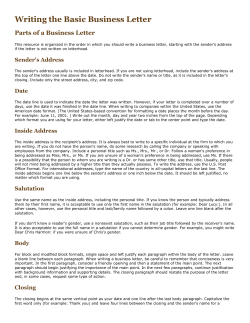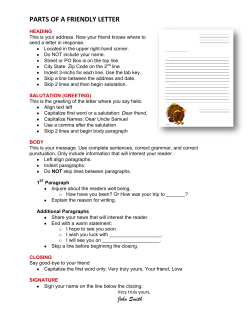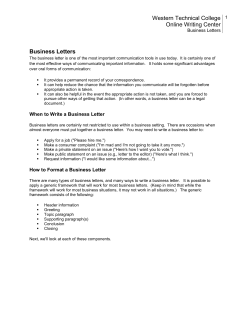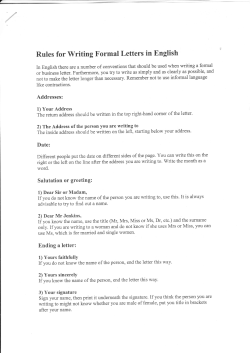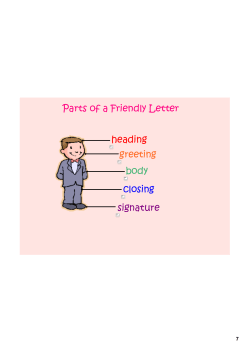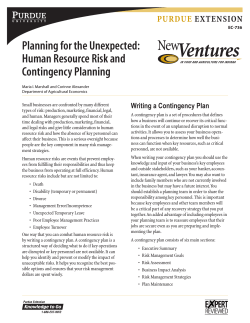
Welcome to the Purdue OWL
Purdue OWL 3/11/14 2:50 AM Welcome to the Purdue OWL This page is brought to you by the OWL at Purdue (https://owl.english.purdue.edu/). When printing this page, you must include the entire legal notice at bottom. Contributors:Elizabeth Angeli and Allen Brizee. Summary: This resource covers the parts of the basic business letter and provides three sample business letters. Writing the Basic Business Letter Parts of a Business Letter This resource is organized in the order in which you should write a business letter, starting with the sender's address if the letter is not written on letterhead. Sender's Address The sender's address usually is included in letterhead. If you are not using letterhead, include the sender's address at the top of the letter one line above the date. Do not write the sender's name or title, as it is included in the letter's closing. Include only the street address, city, and zip code. Date The date line is used to indicate the date the letter was written. However, if your letter is completed over a number of days, use the date it was finished in the date line. When writing to companies within the United States, use the American date format. (The United Statesbased convention for formatting a date places the month before the day. For example: June 11, 2001. ) Write out the month, day and year two inches from the top of the page. Depending which format you are using for your letter, either left justify the date or tab to the center point and type the date. Inside Address The inside address is the recipient's address. It is always best to write to a specific individual at the firm to which you are writing. If you do not have the person's name, do some research https://owl.english.purdue.edu/owl/owlprint/653/ Page 1 of 6 Purdue OWL 3/11/14 2:50 AM by calling the company or speaking with employees from the company. Include a personal title such as Ms., Mrs., Mr., or Dr. Follow a woman's preference in being addressed as Miss, Mrs., or Ms. If you are unsure of a woman's preference in being addressed, use Ms. If there is a possibility that the person to whom you are writing is a Dr. or has some other title, use that title. Usually, people will not mind being addressed by a higher title than they actually possess. To write the address, use the U.S. Post Office Format. For international addresses, type the name of the country in all-capital letters on the last line. The inside address begins one line below the sender's address or one inch below the date. It should be left justified, no matter which format you are using. Salutation Use the same name as the inside address, including the personal title. If you know the person and typically address them by their first name, it is acceptable to use only the first name in the salutation (for example: Dear Lucy:). In all other cases, however, use the personal title and last/family name followed by a colon. Leave one line blank after the salutation. If you don't know a reader's gender, use a nonsexist salutation, such as their job title followed by the receiver's name. It is also acceptable to use the full name in a salutation if you cannot determine gender. For example, you might write Dear Chris Harmon: if you were unsure of Chris's gender. Body For block and modified block formats, single space and left justify each paragraph within the body of the letter. Leave a blank line between each paragraph. When writing a business letter, be careful to remember that conciseness is very important. In the first paragraph, consider a friendly opening and then a statement of the main point. The next paragraph should begin justifying the importance of the main point. In the next few paragraphs, continue justification with background information and supporting details. The closing paragraph should restate the purpose of the letter and, in some cases, request some type of action. Closing The closing begins at the same vertical point as your date and one line after the last body paragraph. Capitalize the first word only (for example: Thank you) and leave four lines between the closing and the sender's name for a signature. If a colon follows the salutation, a comma should follow the closing; otherwise, there is no punctuation after the closing. Enclosures If you have enclosed any documents along with the letter, such as a resume, you indicate this simply by typing Enclosures one line below the closing. As an option, you may list the name of each document you are including in the envelope. For instance, if you have included many documents and need to ensure that the recipient is aware of each document, it may be a good idea to list the names. https://owl.english.purdue.edu/owl/owlprint/653/ Page 2 of 6 Purdue OWL 3/11/14 2:50 AM Typist initials Typist initials are used to indicate the person who typed the letter. If you typed the letter yourself, omit the typist initials. A Note About Format and Font Block Format When writing business letters, you must pay special attention to the format and font used. The most common layout of a business letter is known as block format. Using this format, the entire letter is left justified and single spaced except for a double space between paragraphs. Modified Block Another widely utilized format is known as modified block format. In this type, the body of the letter and the sender's and recipient's addresses are left justified and single-spaced. However, for the date and closing, tab to the center point and begin to type. Semi-Block The final, and least used, style is semi-block. It is much like the modified block style except that each paragraph is indented instead of left justified. Keep in mind that different organizations have different format requirements for their professional communication. While the examples provided by the OWL contain common elements for the basic business letter (genre expectations), the format of your business letter may need to be flexible to reflect variables like letterheads and templates. Our examples are merely guides. If your computer is equipped with Microsoft Office 2000, the Letter Wizard can be used to take much of the guesswork out of formatting business letters. To access the Letter Wizard, click on the Tools menu and then choose Letter Wizard. The Wizard will present the three styles mentioned here and input the date, sender address and recipient address into the selected format. Letter Wizard should only be used if you have a basic understand of how to write a business letter. Its templates are not applicable in every setting. Therefore, you should consult a business writing handbook if you have any questions or doubt the accuracy of the Letter Wizard. Font Another important factor in the readability of a letter is the font. The generally accepted font is Times New Roman, size 12, although other fonts such as Arial may be used. When choosing a font, always consider your audience. If you are writing to a conservative company, you may want to use Times New Roman. However, if you are writing to a more liberal company, you have a little more freedom when choosing fonts. Punctuation https://owl.english.purdue.edu/owl/owlprint/653/ Page 3 of 6 Purdue OWL 3/11/14 2:50 AM Punctuation after the salutation and closing - use a colon (:) after the salutation (never a comma) and a comma (,) after the closing. In some circumstances, you may also use a less common format, known as open punctuation. For this style, punctuation is excluded after the salutation and the closing. Contributors:Elizabeth Angeli and Allen Brizee. Summary: This resource covers the parts of the basic business letter and provides three sample business letters. Sample Letters If you are using letterhead, do not include the sender's address at the top of the letter; instead, begin with the date. Block Format 123 Winner's Road New Employee Town, PA 12345 March 16, 2001 Ernie English 1234 Writing Lab Lane Write City, IN 12345 Dear Mr. English: The first paragraph of a typical business letter is used to state the main point of the letter. Begin with a friendly opening; then quickly transition into the purpose of your letter. Use a couple of sentences to explain the purpose, but do not go in to detail until the next paragraph. Beginning with the second paragraph, state the supporting details to justify your purpose. These may take the form of background information, statistics or first-hand accounts. A few short paragraphs within the body of the letter should be enough to support your reasoning. Finally, in the closing paragraph, briefly restate your purpose and why it is important. If the purpose of your letter is employment related, consider ending your letter with your contact information. However, if the purpose is informational, think about closing with gratitude for the reader's time. Sincerely, Lucy Letter https://owl.english.purdue.edu/owl/owlprint/653/ Page 4 of 6 Purdue OWL 3/11/14 2:50 AM Modified Block Format (Tab to center, begin typing) 123 Winner's Road New Employee Town, PA 12345 March 16, 2001 Ernie English 1234 Writing Lab Lane Write City, IN 12345 Dear Mr. English: The first paragraph of a typical business letter is used to state the main point of the letter. Begin with a friendly opening; then quickly transition into the purpose of your letter. Use a couple of sentences to explain the purpose, but do not go in to detail until the next paragraph. Beginning with the second paragraph, state the supporting details to justify your purpose. These may take the form of background information, statistics or first-hand accounts. A few short paragraphs within the body of the letter should be enough to support your reasoning. Finally, in the closing paragraph, briefly restate your purpose and why it is important. If the purpose of your letter is employment related, consider ending your letter with your contact information. However, if the purpose is informational, think about closing with gratitude for the reader's time. (Tab to center, begin typing) Sincerely, (Tab to center, begin typing) Lucy Letter Semi-Block Format 123 Winner's Road New Employee Town, PA 12345 March 16, 2001 Ernie English 1234 Writing Lab Lane Write City, IN 12345 Dear Mr. English: (Indent) The first paragraph of a typical business letter is used to state the main point of the letter. Begin with a friendly opening; then quickly transition into the purpose of your letter. Use a couple of sentences to explain the purpose, but do not go in to detail until the next https://owl.english.purdue.edu/owl/owlprint/653/ Page 5 of 6 Purdue OWL 3/11/14 2:50 AM paragraph. (Indent) Beginning with the second paragraph, state the supporting details to justify your purpose. These may take the form of background information, statistics or first-hand accounts. A few short paragraphs within the body of the letter should be enough to support your reasoning. (Indent) Finally, in the closing paragraph, briefly restate your purpose and why it is important. If the purpose of your letter is employment related, consider ending your letter with your contact information. However, if the purpose is informational, think about closing with gratitude for the reader's time. Sincerely, Lucy Letter https://owl.english.purdue.edu/owl/owlprint/653/ Page 6 of 6
© Copyright 2025

